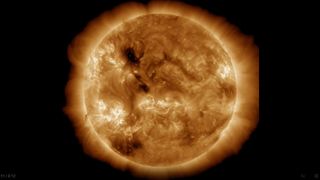Space weather is a growing threat. This new NASA center aims to help protect us
A new space weather forecasting center at the University of Michigan seeks to improve solar weather forecasting.

Space is a dangerous place, especially when it comes to high-energy particles, and intense solar activity can pose threats to people and technology on Earth. To address the potential dangers, NASA has provided five years' worth of funding for CLEAR, a space weather forecasting center at the University of Michigan.
The sun is anything but quiet. Its surface boils at over 10,000 degrees Fahrenheit (5,500 degrees Celsius), with complex electric and magnetic fields twisting, winding and plunging in and out of the depths. This intricate relationship between the superheated plasma of the sun and its own magnetic fields creates the conditions for solar storms. These events — including flares, eruptions and coronal mass ejections — release tremendous amounts of energy into the solar system.
Sometimes the releases take the form of pure radiation. Sometimes entire blobs of sun stuff launch from the surface, moving slowly toward the planets. But often, the sun launches storms of tiny, charged particles known as solar energetic particles (SEPs) — electrons and protons traveling at nearly the speed of light.
Related: Sun blasts out powerful X-class solar flare, causing radio blackouts on Earth (video)
SEPs can really pack a punch. During periods of intense solar activity, SEPs can slam into Earth, overwhelming its magnetic field and even punching through the atmosphere, raining deadly radiation onto the surface. Anything in space is especially vulnerable. Electronics can get scrambled, and sensors can get damaged.
A single strong event can exceed the lifetime dose of radiation for astronauts. Indeed, radiation damage is considered one of the biggest barriers to long-term space travel, as SEPs can damage DNA and lead to cancer — a problem we'll have to solve if we want regular human missions to Mars and beyond.
SEPs' incredible speed allows them to reach Earth orbit in minutes, meaning we have little warning when an SEP storm is about to hit. Recognizing the severity of the problem, NASA recently awarded a team of researchers at the University of Michigan a five-year grant to build the CLEAR Space Weather Center of Excellence, which will focus on providing accurate and timely space weather forecasts to warn of SEP storm events.
Get the Space.com Newsletter
Breaking space news, the latest updates on rocket launches, skywatching events and more!
The CLEAR center will bring together astronomers and astrophysicists with a wide variety of specialties, ranging from observers to theorists, to tackle the problem of SEP prediction. They will use theoretical models of the solar surface to predict when solar flares and coronal mass ejections, which launch SEPs, are likely to erupt.
There are currently 36 models used by various groups. Some, which rely purely on known physics, are very accurate but expensive to run — especially in real time, when every minute counts. So, even if we were to catch a coronal mass ejection going off, we would have enough time to predict the severity of the SEP storm by the time it reached Earth.
The other approach is to use the properties of past storm events to predict when a new one will come. These machine learning techniques are far faster, as they use simple algorithms to determine if the right conditions arise on the sun's surface. But they are currently much less accurate and less reliable, since the algorithms don't "know" the underlying physics; they just try to match observed conditions with the probability of an SEP storm eruption.
With the CLEAR center, space weather forecasters hope to combine these two approaches. The aim is to build faster and more efficient physics-based models and use them to augment the history-based models, resulting in an efficient pipeline that can use real-time data from the sun to provide quick, accurate forecasts of SEP storm events. NASA can then broadcast these forecasts to warn satellite operators and human spaceflight missions about the impending threat, thereby helping all space activities mitigate the damage caused by these storms.
Join our Space Forums to keep talking space on the latest missions, night sky and more! And if you have a news tip, correction or comment, let us know at: community@space.com.

Paul M. Sutter is an astrophysicist at SUNY Stony Brook and the Flatiron Institute in New York City. Paul received his PhD in Physics from the University of Illinois at Urbana-Champaign in 2011, and spent three years at the Paris Institute of Astrophysics, followed by a research fellowship in Trieste, Italy, His research focuses on many diverse topics, from the emptiest regions of the universe to the earliest moments of the Big Bang to the hunt for the first stars. As an "Agent to the Stars," Paul has passionately engaged the public in science outreach for several years. He is the host of the popular "Ask a Spaceman!" podcast, author of "Your Place in the Universe" and "How to Die in Space" and he frequently appears on TV — including on The Weather Channel, for which he serves as Official Space Specialist.
